Responding To COVID-19 / Serving The Mission / Advancing Strategic Initiatives / Managing & Mitigating Risk / Looking Ahead
Following on the heels of the university’s initial pandemic response in early 2020, the next academic year of 2020-2021 continued to rank among the most challenging in recent memory. In fall 2020, DoIT focused on providing fully operational, robust and secure IT infrastructure to enable remote learning, teaching, research and work, as well as support health and safety on campus via university-wide COVID-19 testing, building access, network enhancements, isolation and quarantine management, and other emergency operations. Zoom was launched and integrated with the Canvas learning management system to provide instructors and students with a dynamic, user-friendly remote classroom experience.
As important as those efforts were, DoIT wasn’t focused solely on pandemic-related operations. In spring 2021, the Office of Cybersecurity rolled out cybersecurity awareness training to all UW–Madison faculty and staff with training for students scheduled to take place in fall 2021. The WiscList email list service migrated to a more reliable infrastructure. Multi-factor authentication was added to WiscVPN (virtual private network), improving the university’s cybersecurity posture to better protect our data and our employees’ personal information. The Next Generation Network upgrade project completed installation and conversion of 13,000 wireless access points for 170 campus buildings.
Throughout the year, DoIT continued to prioritize diversity, inclusion and equity efforts with a number of all-staff and university-wide events and learning opportunities. The UW–Madison IT Talks Technical initiative was launched, aimed at eliminating technical terms with historically racist connotations. And working with the Gallup organization, DoIT launched an all-staff climate survey to capture the pulse of DoIT staff and identify areas for improvement.
DoIT continues to have a commitment to building a strong and resilient foundation for IT infrastructure, capturing efficiencies throughout the university through partnerships such as the Administrative Information Management Services (AIMS)/DoIT merger and the co-location of data center services. In the 2021-2022 academic year, we continue to be dedicated to that commitment.
This report summarizes the accomplishments of the past year, and outlines key initiatives and issues that lie ahead.
UW–Madison Mission Statement (excerpt)
The primary purpose of the University of Wisconsin–Madison is to provide a learning environment in which faculty, staff and students can discover, examine critically, preserve and transmit the knowledge, wisdom and values that will help ensure the survival of this and future generations and improve the quality of life for all. The university seeks to help students to develop an understanding and appreciation for the complex cultural and physical worlds in which they live and to realize their highest potential of intellectual, physical and human development.
DoIT’s Mission
We are a collaborative information and technology community working to enable innovation, support scholarship, and equip the university with high-quality, sustainable technologies and services.
Responding To COVID-19
Throughout the 2020-21 academic year, DoIT continued our dedication to responding to the ever-evolving technology needs of the university brought on by the ongoing COVID-19 pandemic.
Following the initial heavy lift when the pandemic first sent university operations primarily online in spring 2020, DoIT analyzed what worked and what was needed to enable a mostly remote fall 2020 term, and spent summer 2020 refining services and technology. We’ve continued to pivot, adapt and support the university at every turn throughout the 2020-2021 academic year, keeping step with the university’s changing COVID-related operations.
This significant body of often rapidly-changing work represented a major collaborative effort, both across DoIT and within the broader university community. These efforts included:
Safer Badgers
The start of the fall 2020 semester brought new challenges to the university. University Health Services (UHS) needed to deploy significant changes to its electronic health records system, roll out a massive COVID testing program at multiple sites across campus, and integrate with Public Health Madison & Dane County and commercial testing labs. DoIT, Administrative Information Management Services (AIMS) and UHS came together in a collaborative effort to evaluate IT systems, load, processes, risks and mitigations to accommodate a wide range of rapid, ever-evolving changes.
In the university-wide effort to build and maintain the Safer Badgers app and related technology infrastructure, each team within DoIT played a part in supporting the health and safety of the university community by assisting with the technology needed to maintain UW–Madison operations:
- User Services and the Help Desk coordinated a large-scale mobile phone distribution system, Safer Badgers app documentation, and the large increase in Help Desk calls.
- Network Services played a key role in the set-up of the COVID testing sites secure wifi. The VoIP team worked with UHS to set up and expand call centers throughout campus to handle the increased call volume from students, parents, faculty and staff.
- Systems Engineering & Operations helped manage complex process and incident response issues.
- Application Infrastructure Services had a critical role in tying various identity and access management pieces together.
- Web and Mobile Solutions (WaMS) developed custom applications for COVID-19 surge testing as well as solutions for verification of Badger Badge state.
- In Enterprise Business Services, Salesforce-powered processes helped tackle complicated isolation and quarantine efforts as well as track COVID-19 testing compliance.
- The Project Management Office helped bring together all parts of the project, and played the critical role of documenting business needs and data flows maps.
- Cybersecurity evaluated the different applications deployed throughout the response efforts.
- Academic Technology provided training assistance.
- With a forward-looking focus on digital accessibility for all, the Center for User Experience worked with the Safer Badgers app vendor to identify and advocate for accessibility-related improvements.
- Human Resources and Financial Services helped navigate a variety of issues, and the Communications team disseminated information to our audiences along the way—including web pages, interactive app walk-throughs, and helping to answer a continuous stream of stakeholder questions.
- Communications created guides and documentation for remote work and learning, collaborated on the university’s COVID-19 site, and created a Scam Alerts web section in response to the increase in COVID-19 scams.
Evolving Help Desk Services
Over the past year, we’ve reinvented the ways in which our Help Desk offers assistance to the university community, adapting to health and safety needs and preferences that have evolved throughout the pandemic.
With our new virtual consults, for example, customers can schedule appointments when it’s convenient for them, without having to leave their homes or offices. This new model allows us to use precision with our staffing, and handle demand based on the list of appointments, rather than guessing when people might stop by for a walk-in consultation. This innovation makes it easier to manage our queue while simultaneously improving the customer’s experience.
The Help Desk also established a locker pickup system in the Computer Sciences Building lobby, allowing faculty, staff and students to pick up laptops, hot spots and other equipment without having to engage in face-to-face contact with Help Desk staff (similar to an Amazon locker pickup model).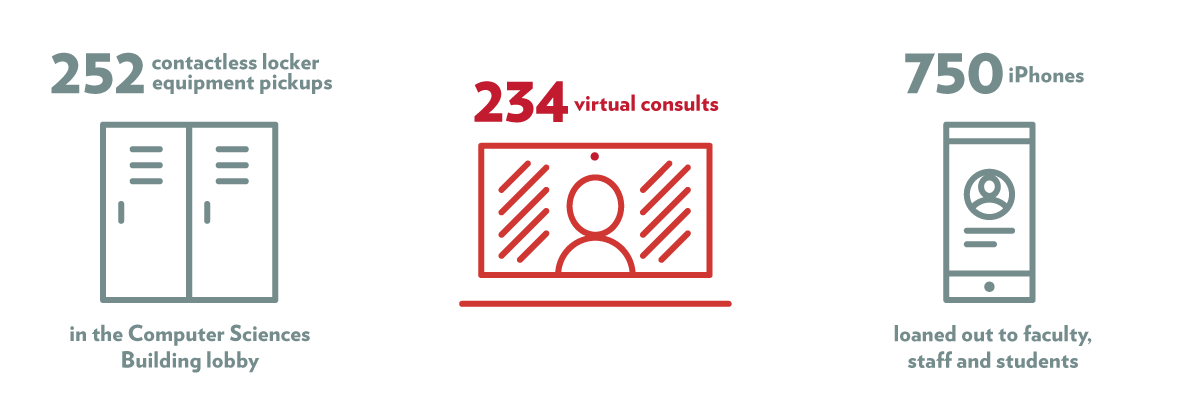
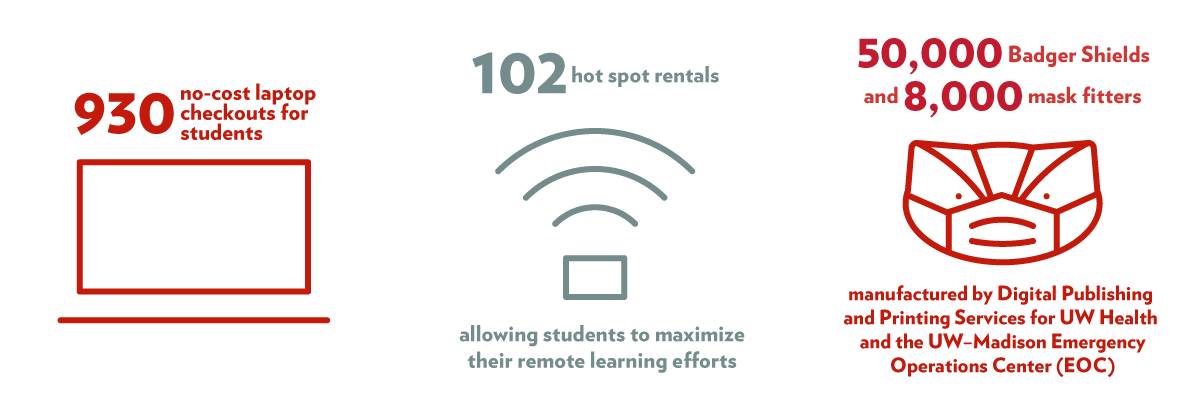
Serving The Mission
DoIT played an instrumental role in supporting the university’s education, instruction and research missions throughout 2020-21.
Enterprise Zoom Implementation
At the onset of the pandemic shift to remote instruction, UW–Madison faculty quickly learned and implemented new tools to best accommodate the classroom experience. With this experience, and in anticipation of the ongoing need for nimble virtual classrooms, faculty called for an enterprise Zoom solution in time for the fall 2020 semester.
In response, DoIT outlined a pathway to implement a secure, viable product in a very short period of time. UW–Madison Zoom went live for general university use on August 31, 2020. As part of the rollout, DoIT teamed with UW Extension to provide live training for pre-meeting setup and in-meeting management to more than 1,000 UW–Madison Zoom users.
The project team continues to work with the Zoom Advisory Group and university partners to refine processes, documentation and the UW–Madison Zoom environment.
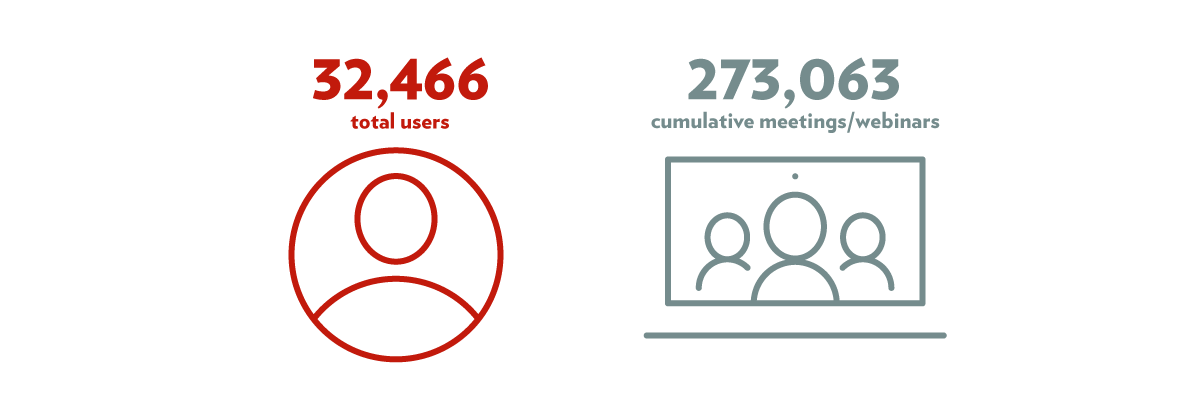
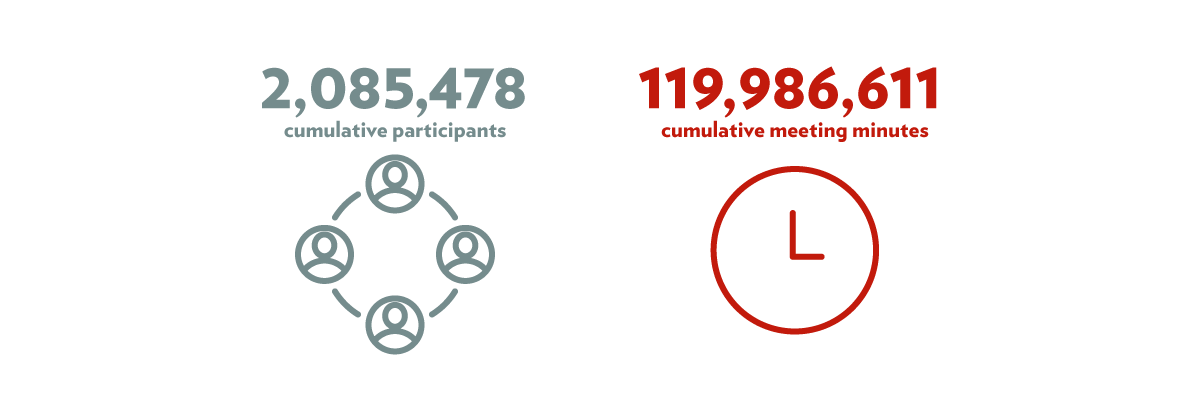
Learning Technologies & Continuity of Instruction
The DoIT Academic Technology team manages the tools and supports the users of the Learn@UW suite that includes the Canvas learning management system, Kaltura media management environment, and 10 other learning technologies. Throughout the year, as part of the university’s broader continuity of instruction effort, the team implemented new tools and capabilities into the digital learning environment, including human captioning within Kaltura, automated proctoring services, learning analytics dashboards, and the ability for students to assert their pronouns within Canvas.
New Learn@UW tools introduced in 2020-21 include the expansion of the Engage pilot to all instructors in spring 2021—saving UW–Madison students $3.5 million and counting in textbook costs by providing publisher eTexts and digital learning tools via Canvas. In the analytics realm, the Learner Engagement Analytics Dashboard (LEAD) helps instructors harness the power of data visualization to answer key questions tied to student success.
Moreover, the team supported a massive influx of additional non-credit, compliance, orientation, and pre-college entities making use of university’s e-learning systems in lieu of being able to provide face-to-face interactions.
Online SOAR & Wiscards
As the university approached a new academic year during a pandemic, UW–Madison faced several challenges. Among them:
Online SOAR: To give incoming Badgers the best possible online experience for Student Orientation, Advising, and Registration (SOAR), DoIT partnered with the Center for the First-Year Experience and the Office of Undergraduate Advising to create a new online program that delivered critical content and engaged new students and their families in a way that felt truly welcoming. All of this was done in about 8 weeks, a feat that a private consulting firm estimated would take 4-6 months.
Issuing Wiscards via CloudCard: In parallel to moving SOAR online, a creative solution was needed to ensure that incoming students could obtain their Wiscards remotely—without having to physically stand in lines at the Wiscard Office.
To accomplish this, DoIT teams implemented a new online photo ID product called CloudCard, an application that allows students to upload their photo, and a photo of their government ID, to prove their identity. Partnering with Union staff, we authenticated submissions from over 7,000 students.
Both the online SOAR and Wiscard processes received positive feedback from students.
Research
In order to grow UW–Madison’s $1.3 billion research enterprise and expand our global impact, our researchers need a diverse set of computing resources, reliable and secure storage, and tools for managing data across its lifecycle. They also need help finding and using these tools and resources. That’s why DoIT and Research Data Services partnered this year to make it easier to find, compare, and get assistance with centralized university research data storage through the new Data Storage Finder Tool.
In a collaboration between the Research Cyberinfrastructure team, UW–Madison Libraries and Research Data Services, the Wisconsin Institute for Discovery and the Data Science Hub, the Researcher Toolkit launched in August 2021. The Researcher Toolkit will help faculty, staff, and student researchers navigate the local research resources available with each phase of their project, from planning to publishing and close-out.
The Wide Area Network (WAN) team kicked off the Globus research data management platform service project to better enable data sharing across universities collaborating on research projects, set up the service, and began initial trial work with various departments.
Advancing Strategic Initiatives
IT projects and strategic initiatives are high-impact and cover a wide range of scope and reach. Projects and initiatives are undertaken in support of furthering the university mission of teaching, research and outreach. Projects and initiatives are centered in both the Division of Information Technology and distributed university IT departments.
Interoperability Transformation
The goal: Establish a modern program for information systems to work together across technical and business domains, to employ common principles, and to expose standardized interfaces to enable delivery of IT services across the enterprise, lower integration cost, increase agility and choice in IT service providers, and more effectively provide access to services and cybersecurity compliance. View the Interoperability project website
2020-21 accomplishments include:
- Procurement activities completed in August 2020, with products selected for identity governance and access management; identity/user profile and self-service; and integration and operational access to data.
- Faster, more precise data integrations were made possible by the implementation of Informatica Intelligent Cloud Services (IICS) as part of the integration platform infrastructure. Partner onboarding continues, including new use cases from Facilities Planning & Management and other university partners.
- The March 2021 launch of the Access, Use and Share Data site, integratedata.wisc.edu, an intuitive, usable way for technical and non-technical users to access guidance, documentation and support to help solve their data business needs. The site uses task-focused language to meet people at their point of need (for example, there’s a guide to help you populate data from a database to a vendor web application using IICS).
- Continued close partnership with the university’s Office of Data Management and Analytics Services (ODMAS), to ensure Interoperability infrastructure and processes fully support the emerging institutional data standards, while building institutional data integration alternatives that support ODMAS strategy.
Next Gen² Network
The goal: To ensure the wired, wireless, and cloud-enterprise network on UW–Madison’s campus is responsive to our instructional, research, business and operational needs now and in the future. View the Next Gen² Network project website
2020-21 accomplishments include:
- The Field Services team completed the installation and conversion of 13,000 wireless access points for 170 buildings.
- Projects launched for outdoor wifi improvements and “Internet of Things” onboarding and management of devices such as robots, freezer alarms, vending machines, and sensors.
IT as a Service
The goal: To increase efficiency, cost savings and resilience for foundational IT services within the UW System by leveraging UW–Madison’s infrastructure economies of scale and eliminating redundancy across the UW System. The concept behind Peoplesoft as a Service, for example, is to leverage the infrastructure UW–Madison already provides to house Student Information Systems across the UW System in a common infrastructure.
The Platform as a Service concept reflects a new UW System strategic direction for IT across all the comprehensive campuses within the system: “Foundational IT” services will be delivered by UW–Madison—such as identity and access management, and enterprise application and platform services—while the local comprehensive campuses within the UW System would continue to manage “mission-focused IT,” including campus operations applications and Student Information Systems.
2020-21 accomplishments include:
- UW-Green Bay was the pilot campus for the Peoplesoft as a Service project, completed August 2021.
- Plans are in place to convert additional UW System institutions into the common Madison infrastructure over the coming year and beyond.
SysNet2020
The goal: The SysNet2020 network will consist of reliable, high-capacity internet access and campus interconnectivity for all UW System institutions. The network will be centrally monitored and managed by UW–Madison personnel and provide acceptable levels of redundancy through commodity circuits and physically diverse fiber paths when possible.
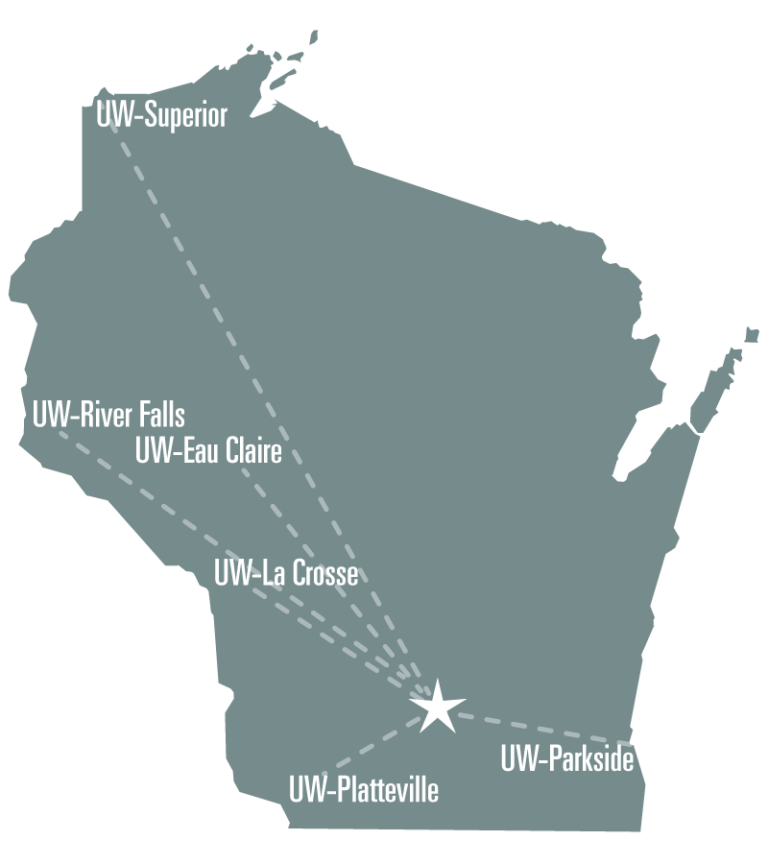
2020-21 accomplishments include establishing or improving network links between UW–Madison and the UW System campuses at Platteville, Eau Claire, Superior, River Falls, La Crosse and other parts of the state. Additional fiber paths were improved between Chicago, Minneapolis and Milwaukee.
Managing & Mitigating Risk
DoIT either leads or supports a wide range of compliance activities for cybersecurity, HIPAA, accessibility, audits, and more. Here are some highlights implemented during the past year that help make our digital university safe.
Endpoint Management
Our focus in 2020-2021 was to deploy solutions to consistently manage endpoints (desktops, laptops, servers and smartphones) and install security agents for computing devices that communicate with the network.
The Endpoint Management service is now largely established—university partners can join the service, have access to training, documentation and support, and can participate in a community of practice. The project team is encouraging broader adoption by implementing new features.
Our Online Environment
The Office of Cybersecurity continues to focus on measures to bolster the security of the university’s infrastructure. Firewalls and Virtual Private Networks (VPNs) provide the first line of defense for a significant number of university devices, and consistent monitoring resulted in 619 suspicious activity notifications in 2020. Cloud-based vulnerability tracking tools collect and report vulnerability information on desktops, laptops and servers.
Malware protection, risk assessment tools and a consolidation of Microsoft Active Directory servers on campus are additional efforts underway to strengthen the university’s cybersecurity environment.
Threat Monitoring
The Cybersecurity Operations Center (CSOC) monitors for intrusion, phishing and suspicious activity. Over the past year, the CSOC processed approximately 113,000 tickets of reported incidents.
The CSOC also searches for threat intelligence, focusing primarily on risks to higher education as well as risks to applications and hardware in use on campus. That information is shared with university technology partners and the larger UW System community.
Tailored Disaster Recovery Plans
The Office of Cybersecurity coordinated the Disaster Recovery response to UW System President Tommy Thompson, isolating and reviewing 28 high-risk systems for current vulnerabilities. In addition, disaster recovery plans and Continuity of Operations Plans (COOP) are now in place for a number of systems. These efforts together help to bolster the university’s cybersecurity posture.
Looking Ahead
We’re proud of the work we’ve done this year to meet the ongoing challenges of a pandemic. At the same time, our work continues in support of all aspects of UW–Madison’s mission. We look forward to creating a new normal in the year ahead. Because of what we’ve learned and implemented during the pandemic, we’re continuing to run IT services in a manner that both saves time for our customers and makes more efficient use of our resources.
We will turn our attention to advance the initiatives outlined in this report—creating and leveraging technology efficiencies across the university, guarding against cyber threats and bringing “Cybersecurity to the Edge,” and continuing to build the “Next Gen” network that underpins it all.
And, we will focus on technology innovation that serves the mission of the university. We are in a strong position to continue enhancing our role supporting IT collaboration and innovation with our university partners.
It takes our entire UW–Madison community, each of us doing our part, to do the work of the university. Our people bring each accomplishment to life—and each person’s well-being and ability to contribute and thrive is our priority. Within DoIT, we are working to improve our climate in support of inclusion, engagement and innovation. We have embraced flexibility for our workforce, recognizing that a modern approach helps each person excel. We’ll continue to identify ways in which we can support professional development and an inclusive, vibrant IT community across the university.
We will actively listen to and collaborate with our university partners and the faculty, staff and students we serve—and we are energized and ready to keep moving the university forward through technology solutions designed together.
